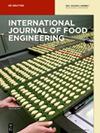Effects of different decaffeination methods on caffeine contents, physicochemical, and sensory properties of coffee
IF 1.4
4区 农林科学
Q3 FOOD SCIENCE & TECHNOLOGY
引用次数: 0
Abstract
Coffee consumption could provide various benefits for human health, but also could contribute to several health problems. The growing trend of coffee consumption has created a rising demand for decaffeinated coffee that is safe for consumers with low caffeine tolerance. Decaffeination process, however, can result in the alteration of several properties of coffee which affect overall coffee taste. This review discussed current decaffeination methods such as water decaffeination, solvent decaffeination, supercritical decaffeination, and biodecaffeination which includes their mechanisms, benefits, and drawbacks as well as their effect in the physicochemical and sensory characteristics of coffee. Solvent decaffeination has showed potential improvements in the future such as the incorporation of membrane and ultrasonic technology. In addition, the mathematical model for caffeine diffusion has been arranged according to Fick’s second law of diffusion, based upon spherical and rectangular coordinates with several assumptions. Further research should be aimed to maintain the properties of coffee after decaffeination process. Furthermore, utilizing new solvents that are safe and non-toxic will potentially be favorable research in the development of decaffeination methods in the future.不同脱咖啡因方法对咖啡中咖啡因含量、理化和感官特性的影响
饮用咖啡可为人类健康带来各种益处,但也可能导致一些健康问题。咖啡消费的增长趋势导致对咖啡因耐受性低的消费者来说安全的低咖啡因咖啡的需求不断增加。然而,低咖啡因工艺会改变咖啡的一些特性,从而影响咖啡的整体口味。本综述讨论了当前的脱咖啡因方法,如水脱咖啡因、溶剂脱咖啡因、超临界脱咖啡因和生物脱咖啡因,包括它们的机理、优点和缺点,以及它们对咖啡理化和感官特性的影响。溶剂脱咖啡因法显示了未来的改进潜力,如采用膜技术和超声波技术。此外,咖啡因扩散的数学模型是根据菲克扩散第二定律,以球形和矩形坐标为基础,在若干假设条件下建立的。进一步的研究应着眼于保持咖啡在脱咖啡因过程后的特性。此外,利用安全无毒的新溶剂也可能是未来开发脱咖啡因方法的有利研究。
本文章由计算机程序翻译,如有差异,请以英文原文为准。
求助全文
约1分钟内获得全文
求助全文
来源期刊

International Journal of Food Engineering
FOOD SCIENCE & TECHNOLOGY-
CiteScore
2.50
自引率
0.00%
发文量
52
审稿时长
3.5 months
期刊介绍:
International Journal of Food Engineering is devoted to engineering disciplines related to processing foods. The areas of interest include heat, mass transfer and fluid flow in food processing; food microstructure development and characterization; application of artificial intelligence in food engineering research and in industry; food biotechnology; and mathematical modeling and software development for food processing purposes. Authors and editors come from top engineering programs around the world: the U.S., Canada, the U.K., and Western Europe, but also South America, Asia, Africa, and the Middle East.
 求助内容:
求助内容: 应助结果提醒方式:
应助结果提醒方式:


